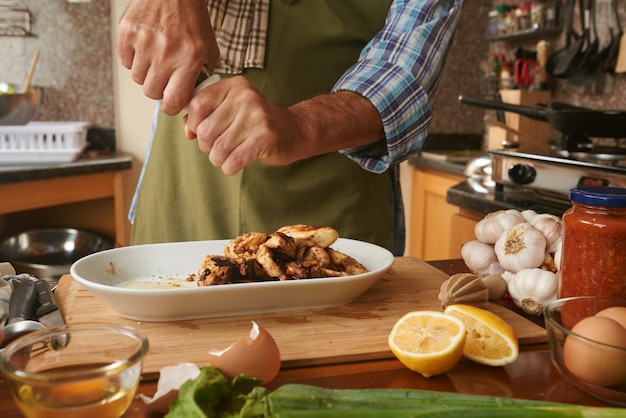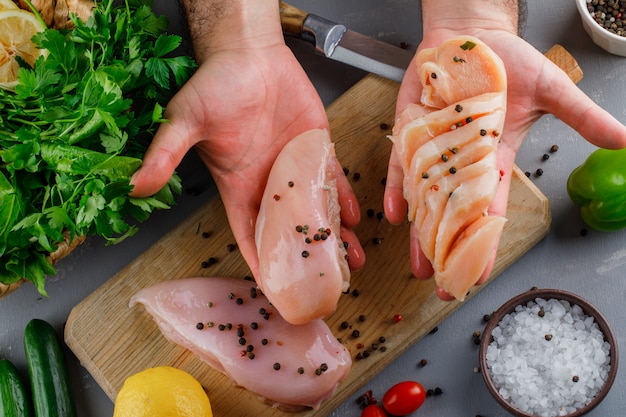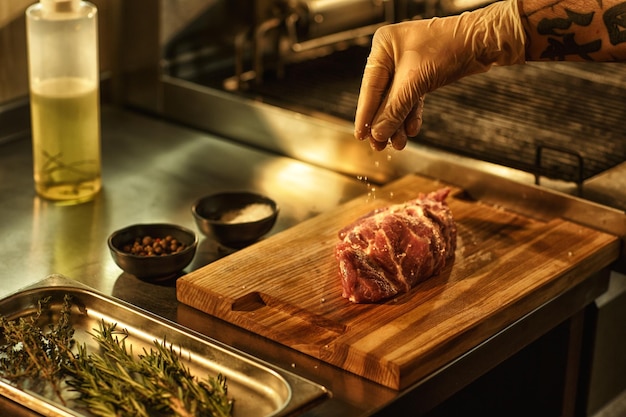Let's face it, there's nothing quite like a perfectly cooked pork chop. That succulent, juicy, and flavorful bite is pure heaven. But we've all had those disappointing experiences with dry, tough, and flavorless pork chops that leave you wondering what went wrong. Well, worry no more! This comprehensive guide will transform you into a pork chop pro, equipping you with the knowledge and confidence to consistently cook the best pork chops you've ever tasted.
(Part 1) Selecting the perfect pork chop

Choosing the right pork chop is the foundation for a delicious meal. It all starts at the butcher counter or supermarket aisle.
1.1 Understanding the Cut
Navigating the various cuts of pork chops can be a bit daunting, but don't worry, it's simpler than you think.
1.1.1 Bone-In vs. Boneless
The first choice you'll face is whether to go bone-in or boneless.
Bone-In: bone-in pork chops tend to be more flavorful. The bone acts as a heat conductor, helping to cook the meat evenly and retain moisture. Plus, they have a classic, rustic charm that elevates any dish.
Boneless: Boneless chops are typically easier to cook and are a great option for grilling or pan-frying. They're also often more affordable, but they can dry out more easily, so pay close attention to cooking times.
1.1.2 Thickness
The thickness of your pork chops impacts the cooking method and time.
Thick Chops: Thick chops are excellent for slow cooking methods like roasting, allowing the heat to penetrate the meat slowly and evenly, resulting in tender, juicy results.
Thin Chops: Thinner chops are perfect for quicker cooking methods like pan-frying or grilling. They cook quickly and evenly, but overcooking them is easy, so keep a watchful eye!
1.1.3 The Cut: Loin, Rib, Shoulder
Each cut of pork has its own unique characteristics.
center cut Loin Chops: These are the most tender and flavorful chops, typically from the center of the loin. They tend to be the most expensive, but their superior quality makes them worth the investment.
Rib Chops: Rib chops, as their name suggests, come from the rib section. They are typically richer in fat and flavor than loin chops, but they can be a bit tougher.
Shoulder Chops: Shoulder chops are the most economical option, but they are also the toughest cut. They require longer cooking times and often benefit from tenderizing techniques to achieve a tender result.
1.2 Choosing the Right Pork
Once you've chosen your cut, it's time to select the pork itself. Look for chops that:
Are Pale in Color: A pale, pink color indicates fresh pork that hasn't been exposed to light for too long.
Are Firm to the Touch: Firmness is a sign of proper handling and quality.
Are Free of Discoloration and Odor: Avoid pork with any discoloration or unusual smells. It's best to choose a different package.
(Part 2) The Art of Seasoning

Seasoning is essential for bringing out the full potential of your pork chops. It's the difference between a bland, ordinary meal and one that will have everyone asking for seconds!
2.1 Basic Seasoning: A Solid Foundation
Start with a simple salt and pepper blend. Freshly ground black pepper adds a wonderful kick that enhances the flavor of the pork.
Garlic Powder: A touch of garlic powder adds a subtle depth of flavor.
Onion Powder: Onion powder brings a savory dimension to your seasoning.
Paprika: Paprika adds a hint of sweetness and a vibrant orange hue.
2.2 Marinades and Brines: Taking Flavor to the Next Level
Marinades and brines are your secret weapons for incredibly juicy and flavorful pork chops.
2.2.1 Marinades: A Flavor Infusion
Citrus Marinades: Lemons, limes, and oranges add a refreshing acidity and brightness that complements the pork.
Soy Sauce Marinades: Soy sauce is a staple in savory marinades, often paired with ginger, garlic, and honey for a complex, umami-rich flavor profile.
Wine Marinades: Red wine marinades add a deep, earthy richness that pairs beautifully with pork.
2.2.2 Brines: Retaining Moisture and Tenderizing
Simple Salt Brine: A basic salt brine helps retain moisture and enhance the natural savory flavor of the pork.
Sugar Brine: Adding a touch of sugar to your brine adds a subtle sweetness and helps to tenderize the meat.
(Part 3) Mastering Cooking Methods

Now that you've chosen your pork chops, seasoned them, and prepped your ingredients, it's time to dive into the cooking process.
3.1 Pan-Frying: A Quick and Easy Weeknight Favorite
Pan-frying is a reliable method for creating delicious pork chops in a hurry.
Choose the Right Pan: A heavy-bottomed pan, like a cast iron skillet, distributes heat evenly, ensuring even cooking and a beautiful golden crust.
Pre-heat Your Pan: Always preheat your pan over medium-high heat before adding your pork chops. This sears the exterior and creates a flavorful crust.
Give Them Space: Avoid overcrowding the pan. If necessary, cook your chops in batches to ensure even cooking.
Searing: Sear the pork chops on each side for a few minutes, creating a beautiful golden-brown crust.
Reduce the Heat: After searing, reduce the heat to medium-low and continue cooking until the internal temperature reaches 145°F (63°C).
3.2 Grilling: Summertime Perfection
grilled pork chops are a classic summertime favorite, bursting with smoky flavor.
Pre-heat Your Grill: A hot grill is crucial for achieving juicy, flavorful pork chops.
Direct vs. Indirect Heat: For thicker chops, use indirect heat and close the lid for even cooking. Thinner chops can be grilled directly over high heat.
Grill Marks: You'll know your chops are ready when they have those iconic grill marks on each side.
Internal Temperature: Always use a meat thermometer to ensure the internal temperature reaches 145°F (63°C).
3.3 Roasting: A Wonderful Option for Large Batches
Roasting is a fantastic option for cooking a large batch of pork chops or for cooking a whole roast.
Preheat Your Oven: A preheated oven at 375°F (190°C) is essential for even cooking.
Use a roasting pan: A roasting pan prevents sticking and helps to distribute the heat evenly.
Roast until Tender: Roast your chops until they reach an internal temperature of 145°F (63°C).
Rest: Let the chops rest for 5-10 minutes before serving. This allows the juices to redistribute, resulting in a more flavorful and tender cut.
(Part 4) Complementary Sides for a Balanced Meal
Pork chops are delicious on their own, but they're even better when paired with the right sides. Think of it as creating a symphony of flavors.
Potatoes: mashed potatoes, roasted potatoes, or potato wedges are classic companions to pork chops, offering a comforting and satisfying base.
Green Vegetables: Broccoli, asparagus, green beans, and Brussels sprouts add a vibrant pop of color and freshness, creating a balanced meal.
Grains: Rice, quinoa, or couscous provide a lighter base for your pork chops, complementing the richness of the meat.
Salads: A simple green salad with a light vinaigrette adds a refreshing touch and balances out the richness of the pork chops.
(Part 5) Knowing When Your Pork Chops are Done
overcooked pork chops are a culinary tragedy, resulting in dry, tough meat. Mastering the signs of doneness will ensure you never overcook your pork.
5.1 The Importance of Internal Temperature
The most reliable way to determine if your pork chops are cooked through is with a meat thermometer. Aim for an internal temperature of 145°F (63°C).
5.2 Visual and Textural Cues
Color: Cooked pork chops will have a light pink to white color throughout, with no trace of pink in the center.
Texture: Cooked pork chops should be firm to the touch, not soft or mushy.
Juices: When you poke a cooked pork chop with a fork, the juices should run clear, not pink.
5.3 The Resting Ritual
Once your chops are cooked, let them rest for 5-10 minutes before slicing. This allows the juices to redistribute throughout the meat, ensuring a succulent and juicy result.
(Part 6) Experimentation is Key: Embrace the Variety
Pork chops are incredibly versatile, allowing you to explore a wide range of flavors and techniques.
6.1 Sauces and Glazes: Adding Depth and Complexity
Pan Sauce: A simple pan sauce created from the pan drippings after cooking your chops can elevate your meal. Add butter, herbs, and wine to the pan for a delicious, flavorful sauce.
Glazes: A glaze is a sweet or savory coating brushed onto the pork chops during the final minutes of cooking, adding a beautiful shine and intense flavor.
honey mustard glaze: This classic combination of honey, mustard, and a touch of garlic creates a sweet and savory glaze that's sure to please.
Maple Syrup Glaze: For a touch of sweetness with a hint of spice, use maple syrup, soy sauce, and a bit of ginger to create a delicious glaze.
6.2 Toppings: A Finishing Touch
Fruit: Apple slices, pears, or peaches add a touch of sweetness and freshness, complementing the savory flavors of the pork chop.
Cheese: Melted cheese, like mozzarella or cheddar, adds a creamy, gooey texture and a rich flavor.
Herbs: Fresh herbs like parsley, thyme, or rosemary add a burst of flavor and aroma.
6.3 Ethnic Influences: Exploring Global Flavors
Asian-Inspired: Marinate your chops in a soy sauce, ginger, and garlic mixture and cook them in a wok with vegetables for a flavorful, Asian-inspired dish.
Mediterranean-Inspired: Use lemon juice, olive oil, oregano, and garlic in your marinade and cook your chops on a grill for a Mediterranean twist.
(Part 7) Troubleshooting Tips: Solutions for Common Challenges
Even the most seasoned cooks encounter challenges in the kitchen. Here are some tips to address common pork chop problems.
7.1 Dry Pork Chops
Dry pork chops are a common issue, but they can be avoided. Here's what to do:
Marinate or Brine: As mentioned earlier, marinating or brining your pork chops before cooking helps retain moisture and enhances flavor.
Don't Overcook: Overcooking is the main culprit for dry pork chops. Use a meat thermometer to ensure your chops are cooked to the correct internal temperature.
Add Moisture: If your chops are already dry, add a bit of sauce or broth to the pan and simmer them for a few minutes to rehydrate them.
7.2 Tough Pork Chops
Tough pork chops are typically a result of overcooking or using a tougher cut of meat.
Cook Longer and Slower: For tougher cuts, slow cooking methods like roasting allow the heat to penetrate the meat slowly and evenly, resulting in a tender result.
Pound the Chops: Pounding tougher chops with a meat mallet breaks down the muscle fibers, making them more tender.
Use a Tenderizer: Add a commercial meat tenderizer to your marinade or brine to help break down proteins and tenderize the meat.
(Part 8) Inspiring Recipes: A Taste of Culinary Delight
Here are a few of my favorite pork chop recipes to get you started.
8.1 pan-seared pork chops with Apple Cider Glaze
Ingredients:
4 boneless, center-cut pork chops
Salt and freshly ground black pepper
1 tablespoon olive oil
1/2 cup apple cider
1/4 cup brown sugar
1 tablespoon Dijon mustard
1/2 teaspoon ground cinnamon
Instructions:
1. Season the pork chops with salt and pepper.
2. Heat the olive oil in a large skillet over medium-high heat.
3. Add the pork chops and cook for 3-4 minutes per side, or until browned.
4. In a small saucepan, combine the apple cider, brown sugar, Dijon mustard, and cinnamon. Bring to a simmer and cook for 5 minutes, or until thickened.
5. Pour the glaze over the pork chops and cook for another 2-3 minutes, or until the glaze is bubbly and the chops are cooked through.
6. Serve immediately.
8.2 Grilled Pork Chops with Mango Salsa
Ingredients:
4 bone-in pork chops
Salt and freshly ground black pepper
1/2 cup mango, diced
1/4 cup red onion, diced
1/4 cup cilantro, chopped
1 tablespoon lime juice
1/2 teaspoon chili powder
Instructions:
1. Season the pork chops with salt and pepper.
2. Preheat a grill to medium-high heat.
3. Grill the pork chops for 4-5 minutes per side, or until cooked through.
4. While the chops are grilling, combine the mango, red onion, cilantro, lime juice, and chili powder in a bowl. Stir to combine.
5. Serve the pork chops with the mango salsa.
8.3 Honey Garlic Roasted Pork Chops
Ingredients:
4 bone-in pork chops
2 tablespoons honey
2 tablespoons soy sauce
1 tablespoon garlic, minced
1 teaspoon ground ginger
1/2 teaspoon black pepper
1/4 cup chicken broth
Instructions:
1. Preheat oven to 375°F (190°C).
2. In a small bowl, whisk together the honey, soy sauce, garlic, ginger, and pepper.
3. Place the pork chops in a roasting pan and pour the honey garlic mixture over them.
4. Pour 1/4 cup of chicken broth into the roasting pan.
5. Roast for 30-35 minutes, or until the chops are cooked through.
6. Serve immediately.
(Part 9) FAQs: Addressing Your Pork Chop Questions
You've got questions about pork chops, I've got answers.
9.1 Can I Freeze Pork Chops?
Absolutely! Pork chops freeze very well. Wrap them tightly in plastic wrap and then in aluminum foil, and store them in the freezer for up to 3 months. When ready to cook, thaw them in the refrigerator overnight.
9.2 How Long Should I cook pork chops?
Cooking time varies depending on the thickness of the chops and the cooking method. For pan-frying, it's typically around 3-5 minutes per side. For grilling, it's 4-5 minutes per side. And for roasting, it's about 30-40 minutes. Always use a meat thermometer to ensure your chops are cooked to the correct internal temperature.
9.3 What are the Best Cuts of Pork for Chops?
The best cuts of pork for chops are the loin and the rib. The loin is the most tender and juicy, while the rib has a bit more fat and flavor.
9.4 What Temperature Should I Cook Pork Chops?
The safe internal temperature for pork chops is 145°F (63°C).
9.5 Can I Use Pork Chops in Other Dishes?
Absolutely! Pork chops are incredibly versatile and can be used in a wide range of dishes. Try them in stir-fries, salads, stews, or even sandwiches.
Everyone is watching

Corn on the Cob: The Ultimate Guide to Perfectly Cooked Ears
Healthy MealsAh, corn on the cob. Just the name evokes images of sunny days, barbecues, and that sweet, juicy flavour that ...

Perfect Pork Roast Oven Cooking Time: A Guide to Delicious Results
Healthy MealsThere's something truly satisfying about a perfectly roasted pork. The aroma alone is enough to make your mout...

Ham Cooking Time: How Long to Bake, Smoke, or Boil a Delicious Ham
Healthy MealsAh, ham. It's a classic, isn't it? A real crowd-pleaser, especially around holidays. And when done right, it'...

Scallops: The Ultimate Guide to Perfect Cooking
Healthy MealsAh, scallops. Those delicate, sweet, and utterly delicious morsels of the sea. They hold a special place in my...

Spaghetti Squash: The Ultimate Guide to Cooking and Serving
Healthy MealsRemember that time you saw spaghetti squash at the supermarket, looking all bumpy and strange, and thought, "W...
